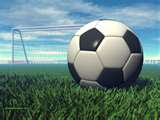Wednesday, February 13, 2008
AZZURRI SOCCER TRYOUTS AND SIGNUPS FOR 2008
Updated March 21, 2008
Who: Boys & Girls
Ages 14-18 as of July 31, 2008
Dates: April 19, 20; 26, and 27, 2008
Time: 9:00 a.m. to 10:00 a.m. for registration
10:00 a.m. to 12:00 p.m. for tryouts
Location: Riverfront Park Soccer Complex
The Azzurri Soccer Club offers competitive soccer within the state. Entering tournaments and playing on Saturdays with other competitve clubs, September - November, Class 3.
If there is enough interest in any one age group and we have willing sponsors and coaches, they will sponsor a Class 1 Competitive Team that may travel out of state and make may compete in the State Cup.
The Azzurri Soccer Club can connect players with tutors and with Olympic Development Teams for interested players.
Friday, February 1, 2008
Notes from the 2008 CYSA Soccer Expo, Oakland, California.
There were useful field demonstrations that had immediate practical use in coaching kids. There was a presentation on working with goal keepers, a presentation on increasing kid’s reaction time and speed to the ball, a demonstration of useful warm-ups and helpful passing drills and a discussion and demonstration of using four fullbacks.
SPEED DRILLS FOR SOCCER
The following activities were included in the program on speed training as a warm up to get the kids speeding up their thinking and getting their bodies active. In a limited area everybody was “it” and had to tag everyone else on the back. Players were asked to go for a minute or up to three minutes at a time. They were asked to keep score. They could block the tag if they could. The idea was to get them running and using their upper body and eyes in an active and quick game. That game then changed to tagging on the back and the knee with special emphasis to avoid bonking heads by bending at the knees to get low to tag at the knee and again encouraging the players to block the tag if they could. While this game appeared to be organized chaos, the kids appeared to be active, be running, and stayed active and running in this game. Again, they were asked to keep score on the number of tags that were successful. The time limit was from one to three minutes depending upon how well they are doing. This game was then expanded to several players being in a limited area and players trying to dribble the ball through the area without getting tagged either on the back or the knee. If the players were able to go through a corner of the area, they would get one point; they could go all the way through the middle without getting tagged, they could get two points; if they were able to go through and tag one of the people in the middle on the back, they could get five points. If the ball was kicked out of the area by one of the players in the middle, they lost all their points and had to restart. That game was run for one to three minutes, changing up the number of players in the middle.
As we know, the points really don’t matter and it is just whatever the coach wants to do with it.
After the kids are warmed up there is, of course, a period of stretching. As part of the running the kids were then encouraged to begin running by leaning and using gravity and teaching the kids to run with their chest forward and leaning as they start to use gravity to save energy and to get a quicker start encouraging the players to use short fast arm strokes what he called, “alligator arms,”(pumping the arms forward and backward at elbow and fist moving forward and back quickly with short strides) and when they got up to speed using high fast arm strokes going from eye socket to hip pocket or cheek to cheek as it were. The development of the arm stroke can be incorporated in the agility ladder when having the kids run through the ladder getting their upper arm working with their lower bodies, the emphasis being getting the upper arms working with the lower body, allows them to move faster.
I would think a coach could experiment as to how fast they run in a 40-yard dash before doing the agility and speed training and then seeing if they increase their speed over a 40-yard dash with these techniques.
The use of the agility ladders was to have the kids go through them forwards, backwards, side to side, deciding how many steps they want in; whether they want cross over steps going through from side to side; they can be used for any practice of fakes but again the emphasis is getting the upper arms working with the lower body to increase quickness.
PASSING DRILLS
Passing drills were demonstrated with 4 players in a line and having the players immediately split off to opposite sides upon beginning of the pass so that they are no longer in line and they could pass backwards; they could pass through the middle in a z form; they could make a long pass, drop back to the middle and back to the beginning; they could do a z pass with a player on the end then running back and using a player to pass to on a give and go; they progress these passing drills into games of 6 on 2 and 5 on 3. Passing drills were also started with 2-touch and then moved to 1-touch, pace of the ball was hard and the players were required to trap the ball within a foot based upon the level of skill. It was easier for the older players to do that than the younger players but obviously those were the things they were working for.


